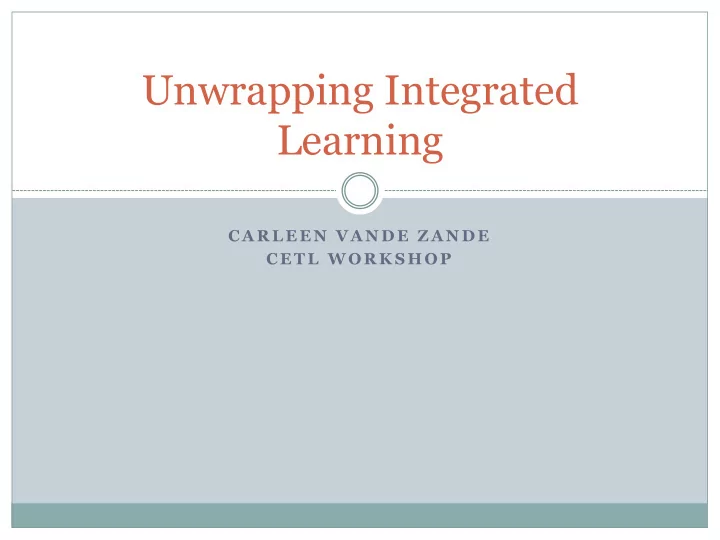

Unwrapping Integrated Learning C A R L E E N V A N D E Z A N D E C E T L W O R K S H O P
How we organize learning for students? Integrated learning helps us capture the spirit of inquiry, discovery, and personal connections that are necessary for deep and meaningful learning
What is integrated learning? Develops the whole student Should prepare students to tackle complex and unscripted problems Emphasizes a variety of student-centered and problem- based pedagogies. Allows students to connect the curriculum, the co- curriculum, and the community Allows for explicit connections among a variety of learning experiences Builds upon strategies that allow students to integrate and demonstrate their learning, reflect upon it, and establish future goals.
Setting the context What opportunities do we offer students to integrate their learning in this way? Where does this type of learning take place? What are challenges to this design?
4 connections or integrations (1) within (3) among their coursework in their curricular and co- major, curricular activities, and (2) between their Program of Liberal (4) across Studies courses and disciplines and their major contexts (often courses, beyond the campus gates).
Think of your own courses/ activities/ major programs Are there times when students are afforded time to “connect the dots?” How do students build upon what they have learned in other courses or experiences?
AAC&U Practices of Integrated Learning PRACTICE — Integrative liberal learning practices feature curricular designs that recognize the stages of student development and the importance of connecting and scaffolding learning experiences.
Examples Research paper course Your examples? assignment drawing from other coursework Portfolio based assessment Capstone courses Internships Study Abroad
AAC&U Practices of Integrated Learning PRINCIPLE — Integrate curricular, co- curricular, and community experiences
Examples Study abroad courses Your own examples? with pre-post reflection activities Job shadowing, internships Co-curricular experiences connected with the major Community based major courses Service-learning
AAC&U Practices of Integrated Learning PRACTICE — Integrative liberal learning should prepare students to tackle complex and unscripted problems. Integrative liberal learning practices emphasize a variety of student-centered and problem- based pedagogies.
Examples Interdisciplinary Your ideas? thematic courses for first year students Undergraduate research Contemporary issues courses that are interdisciplinary Courses designed around big questions
AAC&U Practices of Integrated Learning PRINCIPLE-enhancing learning through practical application
Examples Problem-based group Your ideas? assignments Alternative spring break or other work projects Internships with assignments promoting reflection and analysis Service-learning courses Major courses focused on community-based research projects
What it looks like in an assessment EXAMPLE — Assignments for integrative liberal learning provide students with opportunities to engage their higher-order thinking skills, such as analysis and synthesis, while incorporating their own points of view. To address a given problem, students need to apply sophisticated knowledge, skills, and values drawn from a strong foundation in the arts, humanities, social sciences, natural sciences, and community- or project-based learning experiences.
Integrated Learning Strategies Identify a specific problem to be addressed, describe the relevant background, and articulate the problem’s importance in a local or global context. Undertake additional research outside of course material to further define the focus and context of a project. Take a position on the subject matter that examines his or her own assumptions and those of others.
AAC&U Integrated Learning Approaches Consider approaches to a problem or question other than the one they have proposed and assess the potential effects on the local or global landscape. Share approaches to a problem or question with others to evaluate their own reasoning and consider next steps and potential redesign or revision. Reflect on their own work, synthesize feedback and consider revisions to their work.
Recommend
More recommend